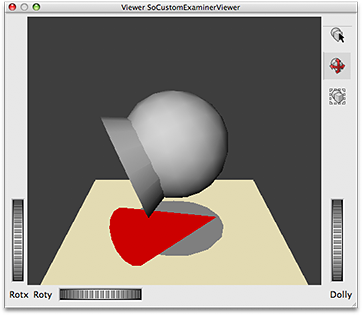SoShadowMaterial¶
- InventorModule¶
genre
author
package
dll
definition
see also
SoShadowCast,SoPickableShadowCast,SoShadowSwitch,SoShadowAwareTransformerManipkeywords
Purpose¶
The SoShadowMaterial module may be used to give individual objects a distinct shadow color.
See: Illustrative Shadows: Integrating 3D and 2D Information Displays. Felix Ritter, Henry Sonnet, Knut Hartmann, and Thomas Strothotte. Proceedings of ACM Intelligent User Interfaces 2003, pp. 166-173.

Usage¶
Connect the SoShadowMaterial module to the scenegraph preceding shapes whose shadow color should be modified.
Details¶
You may also use the module to change nonshadow material parameters.
Output Fields¶
self¶
- name: self, type: SoNode¶
The module has one output connector to include the module into the parent scene.
Parameter Fields¶
Field Index¶
|
|
|
|
|
|
|
|
|
|
|
|
|
|
|
Visible Fields¶
Ambient Color¶
- name: ambientColor, type: String, default: 0.2 0.2 0.2¶
Ambient color of the surface.
Diffuse Color¶
- name: diffuseColor, type: String, default: 0.8 0.8 0.8¶
Diffuse color(s) of the surface.
Specular Color¶
- name: specularColor, type: String, default: 0 0 0¶
Specular color of the surface.
Emissive Color¶
- name: emissiveColor, type: String, default: 0 0 0¶
Emissive color of the surface.
Shininess¶
- name: shininess, type: String, default: 0.2¶
Shininess coefficient of the surface. Values can range from 0.0 for no shininess (a diffuse surface) to 1.0 for maximum shininess (a highly polished surface).
Transparency¶
- name: transparency, type: String, default: 0¶
Transparency value(s) of the surface. Values can range from 0.0 for opaque surfaces to 1.0 for completely transparent surfaces.
Use Shadow Color¶
- name: useShadowColor, type: Bool, default: TRUE¶
If enabled, the given shadow color will be used.
Shadow Color¶
- name: shadowColor, type: String, default: 0.65 0.62 0.51¶
Determines the color of the shadow.
Shadow Offset¶
- name: shadowOffset, type: Vector2, default: 0 0¶
If not ignored (ignored by default), this field can be used to explicitly define how individual shadows should be offset with regard to other shadows.The first component specifies a scale factor that is used to create a variable depth offset for each polygon. The second component is multiplied by an implementation-specific value to create a constant depth offset. See SoPolygonOffset.
Override Render Pass¶
- name: overrideRenderPass, type: Enum, default: SHADOW¶
This field may be used to override subsequent material and shadow assignments.
Values:
Title |
Name |
|---|---|
All |
ALL |
Shadow |
SHADOW |
Nonshadow |
NONSHADOW |